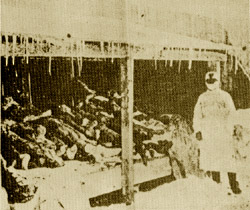

Founded in 1935, there original message, under the guise of the Imperial Army, was the prevention of disease (like the CDC of today).But, covertly, it was to study the effects of certain diseases on the human body. Also, to study the effects of injury of the body here are a few examples:
Physical torture was not the only thing they dabbled in. They did weapons testing, such as testing grenades and flame throwers on POWs. This was done to create better weapons. But, the most disturbing thing of all is that some prisoners were tied down to stakes so the Unit could test germ-laden bombs and chemical weapons.
Not all these poor souls were POWs. They were anti-Japanese partisans, criminals, and people who seemed suspicious to the Japanese secret police. Even infants, the elderly and pregnant women were rounded up. Unit 731 wanted a wide range of people from every walk of life to do their tests.
From the onset of the war, it was Unit 731 (and a second unit, Unit 1644) to conduct chemical and biological warfare on the enemy and his populace. China bore the worst brunt of these attacks. Throughout the war, these Units injected “vaccinations” into the Chinese public during the occupation. These vaccinations in fact were contagions, such as Cholera, Anthrax, Small Pox, Diphtheria, and Plague. There were other ways Unit 731 conducted warfare-dropping infected clothing, food, and supplies disguised as humanitarian airlifts. But, the worst of it all, in 1940, Japanese planes dropped plague-infested fleas over the coastal cities of China. In 1941, they sprayed bubonic plague on the populace of China, resulting in the deaths of thousands due to plague epidemic. It is estimated that at least 200,000 people died in these attacks.
The Unit’s leader, General Shiro Ishii, wanted to use these weapons in the Pacific war against the Americans and British. But, he was thwarted. First, by the stubborn resistance by the Chinese Army, and, in August 1945, Russia invaded Manchuria. When the Soviets invaded, the unofficially disbanded the unit. Personal were issued viles of cyanide in case of capture.
Many Soviet families were killed by the attacks. So, after the war, most of them were tried and convicted as war criminals, receiving 2 to 25 years hard labor in the Siberian Labor Camp. Some unit personnel, however, became part of the Japanese health establishment. One member founded the Japanese Green Cross. While others, sentences commuted, found work in the US-back health schools. General Shiro Ishii, in particular, went to work on bio-weapons research in Maryland.